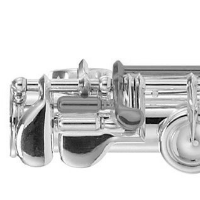The flute, a versatile and melodic woodwind instrument, has a range that is primarily determined by its construction. While the standard flute can comfortably reach down to a low C, many musicians wonder if it is possible to play a low B flat (Bb) on the instrument. The answer is nuanced and depends on the specific flute model, additional equipment, and certain techniques.
Standard Flute Construction and Range
Most student model flutes are equipped with a C footjoint, which features two keys at the end, allowing the player to reach a low C. This setup is common in beginner and intermediate flutes. On the other hand, many intermediate and professional flutes are built with a B footjoint. This design includes three keys at the end of the footjoint, enabling the player to reach a low B natural, just a half-step above the low Bb.

Techniques for Achieving Low B Flat
Beyond physical modifications to the flute, certain techniques can also enable a flutist to play a low Bb. One method involves fingering a low B and then bending the note down a half-step using the embouchure, which is the way a flutist shapes their mouth while playing. This technique is akin to the method used on pan flutes, where players lower the pitch of a note by bending it down a half-tone. This approach works particularly well when the Bb is needed as a transitional note into a B natural, creating a smooth portamento effect.
Another technique, more common on instruments like the recorder, involves covering the end of the flute’s tube to lower the pitch by a semitone. However, this method is considered impractical for the modern flute, which is more complex in its design.
How to play the low B-flat

To play the low B, press the top roller key down with the little finger of your right hand.

